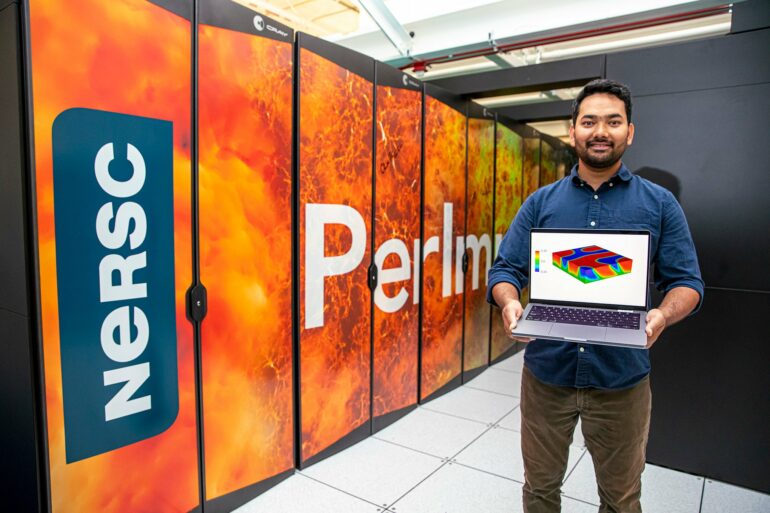Thanks to advances in microchips, today’s smartphones are so powerful they would have been considered supercomputers in the early 1990s. But the rising ubiquity of artificial intelligence and the Internet of Things—the vast network of connected devices that have enabled everything from smart grids to smart homes—will require a new generation of microchips that not only outpace previous records of miniaturization and performance but are also more energy efficient than current technologies.
As part of this effort, Berkeley Lab scientists are working to revolutionize the transistor, one of the fundamental components in computer microchips, for superior performance and energy efficiency. Recent work has shown the promise of new transistor materials that use an unusual property called negative capacitance to enable more efficient memory and logic devices. When a material has negative capacitance, it can store a greater amount of electrical charge at lower voltages, which is the opposite of what happens in conventional capacitive materials.
Now, a multidisciplinary team of researchers have developed an atomistic understanding of the origins of negative capacitance, enabling them to enhance and customize this phenomenon for specific device applications. The advance was made possible by FerroX, an open-source, 3D simulation framework that the team custom-designed for the study of negative capacitance. Their work was reported in the journal Advanced Electronic Materials.
The work represents a significant milestone of a multiyear project, “Co-Design of Ultra-Low-Voltage Beyond CMOS Microelectronics,” which aims to design new microchips that could perform better and require less energy than conventional silicon chips.
While it’s not uncommon for materials development to be closely linked to applications, Berkeley Lab’s co-design approach to microelectronics research, where the atomistic understanding of material properties is driven and informed by specific device requirements, tightens the connection between research aims in all aspects of device development and relies on the interdisciplinary team science for which the lab is famous in the hope of accelerating the pathway from R&D to commercialization.
“There’s a lot of trial and error in the making of new materials. It’s like making a new recipe. Researchers typically have to work days and nights in the lab to change that recipe. But with our modeling tool, FerroX, you can use your own computer to target specific parameters that can affect the performance of the negative capacitance effect,” said Zhi (Jackie) Yao, a research scientist in Berkeley Lab’s Applied Mathematics & Computational Research Division and senior author on the study.
Yao and first author Prabhat Kumar, a postdoctoral scholar in the Applied Mathematics & Computational Research Division, co-led the development of FerroX for the microelectronics co-design project.
Uncovering the atomistic origins of negative capacitance
In 2008, co-author Sayeef Salahuddin, a professor of electrical engineering and computer sciences at UC Berkeley and senior faculty scientist in Berkeley Lab’s Materials Sciences Division, first proposed the concept of negative capacitance to demonstrate a new approach to designing energy-efficient computers.
Negative capacitance typically appears in materials with ferroelectric properties. Ferroelectric materials have promise as energy-efficient computer memories because their built-in electrical polarization can be used to store data, for example, that can be written and erased using a low-power electric field.
In the years following Salahuddin’s pioneering proposal, researchers have learned that the negative capacitance effect in thin films of ferroelectric hafnium oxide and zirconium oxide (HfO2-ZrO2) occurs when the films are composed of a mixture of phases.
That means that small regions or “grains” of the film have slightly different arrangements of atoms or “phases.” The size of these phase grains are tiny—just a few nanometers across—but the different phases have distinct electronic properties that can interact with each other and give rise to macroscopic phenomena such as negative capacitance.
The Salahuddin group has already made use of this phenomenon to produce record-breaking microcapacitors, but in order to unlock the full potential of negative capacitance, the researchers needed a deeper understanding of its atomistic origins.
To do this, a multidisciplinary team co-led by Yao and Kumar developed FerroX. The open-source framework allowed them to develop 3D phase-field simulations of a ferroelectric thin film, in which they could vary the phase composition at will and study the impacts on the film’s electronic properties.
“Our goal was to understand the origin of negative capacitance in these films, which is not well understood,” Kumar said. “Our simulations are the first to help researchers tailor a material’s properties for further improvements in negative capacitance observed in the lab.”
As a result, the Berkeley Lab researchers found that the negative capacitance effect can be enhanced by optimizing the domain structure—reducing the size of the ferroelectric grains and arranging them to have a particular direction of ferroelectric polarization.
“This approach to enhancing negative capacitance was unknown before our study because previous models lacked the scalability to easily explore the design space and lacked physics customization,” Yao said.
Yao attributes this new modeling capability to working firsthand with materials scientists like Salahuddin, who helped the FerroX development team understand how to shape their models around the physics of ferroelectrics, and to the unique multidisciplinary strengths of Berkeley Lab, where researchers across the scientific disciplines are in close proximity to the Perlmutter supercomputer at the Department of Energy’s National Energy Research Scientific Computing Center (NERSC).
Perlmutter supports complex simulation, data analytics, and artificial intelligence experiments requiring multiple graphics processing units (GPUs) at a time. Yao, Kumar, and team relied significantly on Perlmutter to develop FerroX, which is now available to other researchers as an open-source framework that is portable from laptops to supercomputers.
“It’s exciting that FerroX will be able to help such a vast community of researchers in academia, industry, and the national labs,” Yao said.
While FerroX models in the current study simulate the origin of negative capacitance as it evolves at the transistor gate, the Berkeley Lab team plans to use the open-source framework to simulate the entire transistor in future studies.
“Over the years, we have made significant progress in both the physics of negative capacitance and integrating that physics into real microelectronics devices,” said Salahuddin. “With FerroX, we can now model these devices starting from atoms, and that will allow us to design microelectronics devices with optimal negative capacitance performance. That would not have been possible without the strength of this co-design group of researchers spanning computing sciences and materials sciences.”
More information:
Prabhat Kumar et al, 3D Ferroelectric Phase Field Simulations of Polycrystalline Multi‐Phase Hafnia and Zirconia Based Ultra‐Thin Films, Advanced Electronic Materials (2024). DOI: 10.1002/aelm.202400085
Provided by
Lawrence Berkeley National Laboratory
Citation:
New computer simulations help scientists advance energy-efficient microelectronics (2024, September 12)



